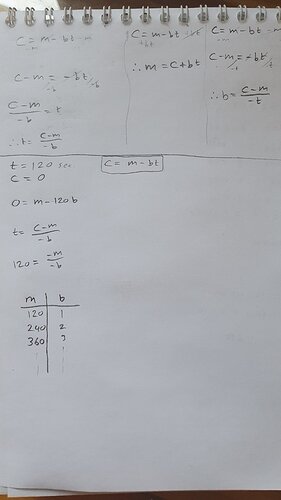Great work giving this challenge a go @anitconsultantllc.
For your first equation, you’ve made a small mistake when moving ‘c’ to the other side.
Rather than dividing both sides by c, you need to subtract instead.
This will leave you with -m = -bt - c. From there, you can multiply both sides by -1 to get m = bt + c.
For the second equation, it’s difficult to separate b straight away, like you’ve tried to do.
Doing so would leave you with (c/b) = (m/b) - t, which actually gets you slightly further away from the answer - Remember that you have to apply the division to everything on both sides.
For this one, it’s actually easier to strip everything else away from the right hand side and leave b alone.
Give this one another try and then check the solution below:
c = m - (b * t)
c - m = -bt <- Subtract m from both sides
(c - m) / -t = b <- Divide both sides by -t
b = (c - m) / -t <- Swap the sides to tidy everything up
Then, once you’ve got your two equations, try plugging in the numbers for our designer to see which numbers we could use for the maxFuel and burnRate.
I hope all of that makes sense but if you have any questions, please let me know.


